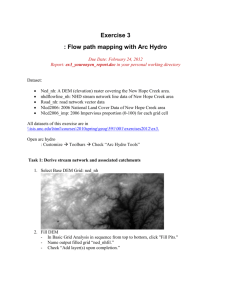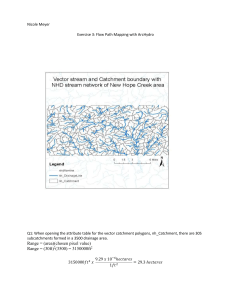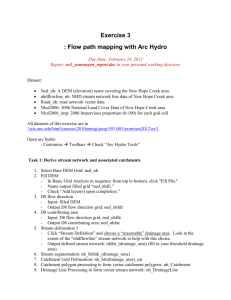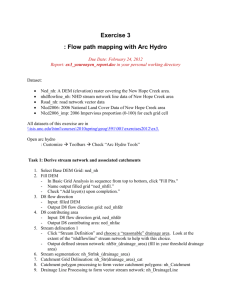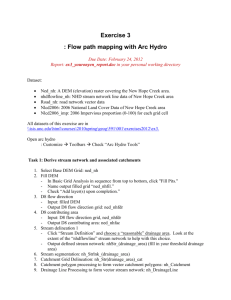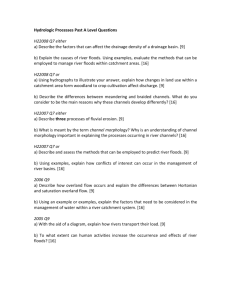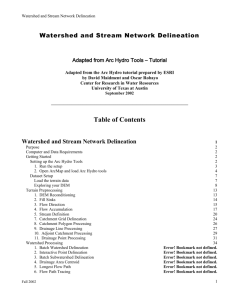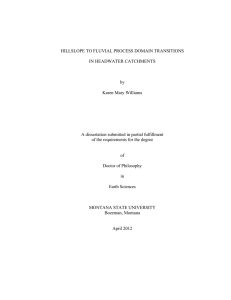ex3_jamesan_report_g..
advertisement
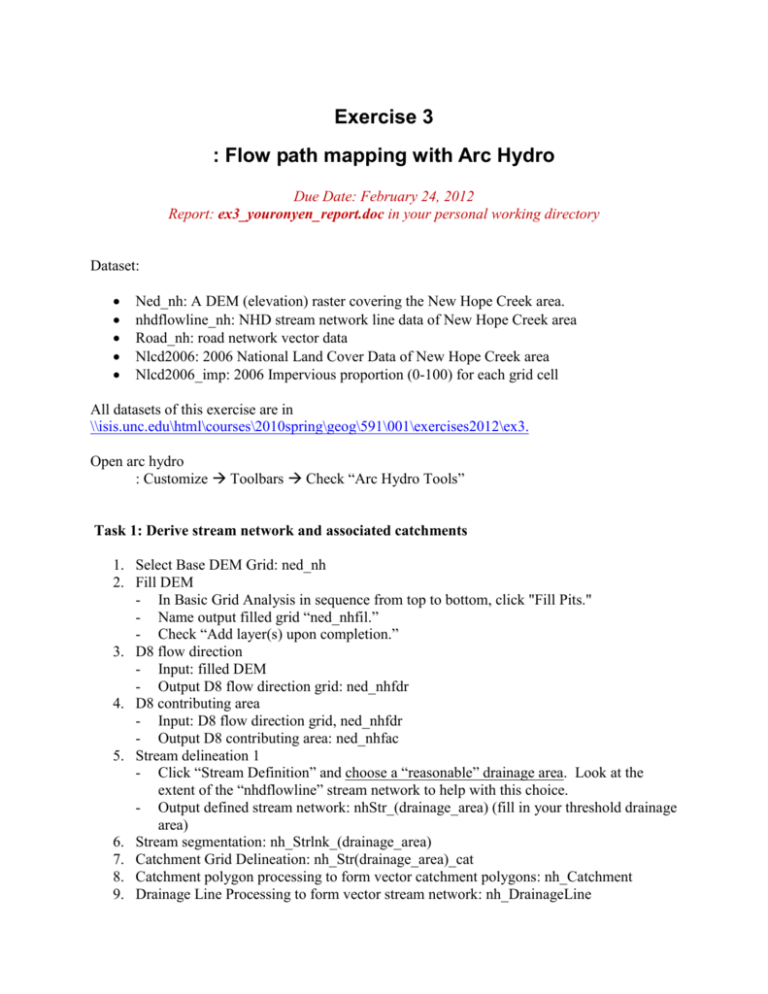
Exercise 3 : Flow path mapping with Arc Hydro Due Date: February 24, 2012 Report: ex3_youronyen_report.doc in your personal working directory Dataset: Ned_nh: A DEM (elevation) raster covering the New Hope Creek area. nhdflowline_nh: NHD stream network line data of New Hope Creek area Road_nh: road network vector data Nlcd2006: 2006 National Land Cover Data of New Hope Creek area Nlcd2006_imp: 2006 Impervious proportion (0-100) for each grid cell All datasets of this exercise are in \\isis.unc.edu\html\courses\2010spring\geog\591\001\exercises2012\ex3. Open arc hydro : Customize Toolbars Check “Arc Hydro Tools” Task 1: Derive stream network and associated catchments 1. Select Base DEM Grid: ned_nh 2. Fill DEM - In Basic Grid Analysis in sequence from top to bottom, click "Fill Pits." - Name output filled grid “ned_nhfil.” - Check “Add layer(s) upon completion.” 3. D8 flow direction - Input: filled DEM - Output D8 flow direction grid: ned_nhfdr 4. D8 contributing area - Input: D8 flow direction grid, ned_nhfdr - Output D8 contributing area: ned_nhfac 5. Stream delineation 1 - Click “Stream Definition” and choose a “reasonable” drainage area. Look at the extent of the “nhdflowline” stream network to help with this choice. - Output defined stream network: nhStr_(drainage_area) (fill in your threshold drainage area) 6. Stream segmentation: nh_Strlnk_(drainage_area) 7. Catchment Grid Delineation: nh_Str(drainage_area)_cat 8. Catchment polygon processing to form vector catchment polygons: nh_Catchment 9. Drainage Line Processing to form vector stream network: nh_DrainageLine 10. Make map with 1) vector stream (nh_DrainageLine) and 2) catchment boundary (nh_Catchment) that you made in Task1, and 3) nhdflowline. Q1. How many subcatchments were formed in your watershed partitioning? What was the drainage area in hectares that you used to define the beginning of each channel? ANSWER: 388 subcatchments were formed in the watershed partitioning. I used a drainage area of 2800 to define the beginning of each channel. This is a 30m resolution DEM. So the drainage area is (30m * 30m) *(2000~3500 pixels) *0.000 1 m2/ha = 180 ~ 315 ha (-3.0) Q2. Remember this is all a model. What key assumptions were made, and how would you want to improve the watershed delineation to better match field conditions? ANSWER: Since this is just a model, it is a representation of the real world, it is not completely accurate. The key assumption that we use in this model is that the NHD Flowlines are accurate, however we know that anytime we try to turn a natural flowing/wondering path to a straight line there is some margin of error. Also, we derive the flowlines from the DEM, which is just another model of elevation. The assumptions are 1) We based flow direction on the D8 system. So we are assuming that water does not flow in split paths but just flows in one D8 direction from a higher elevation in the DEM. 2) It does not account for water infrastructure that re-directs flows. Ways to improve are 1) D-inf flow direction 2) Burning process by vector stream data 3) considering urban water drainage infrastructure (-5.0). Task 2: Derive catchment level statistics of land cover 1. Zonal statistics (mean) for impervious cover for all catchments – map and table using hydroid 2. Zonal statistics (majority) for land cover for all catchments – map and table using hydroid 3. Zonal statistics histogram for land cover for all catchments – table using hydroid Q3. Make impervious cover and land cover zonal statistics maps with your catchment boundary shape file. According to the zonal maps and tables, what is the range of % impervious area for the catchments? The range of mean impervious cover for all catchments is 0-59.97% -The range of mean % impervious cover is 0 – 60.7 (17/25)

